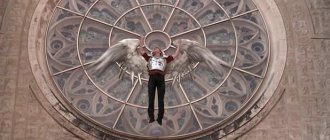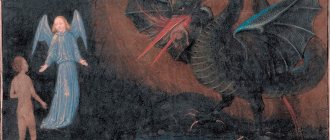What are the circles of hell?
The concept of hell first appeared in the biblical New Testament. Christians were convinced that after death sinners go to the afterlife, where they are subjected to suffering and torment. After going through 7 circles of hell, they are cleansed of filth and can be accepted into heaven. A specific sin is clearly attached to each section, the punishment for it is determined in advance. No one says exactly how many circles of hell the offender must cross, but the hierarchy of the underworld changes in Catholicism. Aristotle increased the number of circles to nine, and then his idea was picked up by the Italian thinker Dante Alighieri.
New in blogs
A trip to Hell – literally.
We will talk about the almost canonical and modern architecture of Hell, which was revealed to us by Dante Alighieri (1265-1321) - an Italian poet, one of the founders of the literary Italian language. There were many models of Hell.
As soon as Christianity arose, models of Hell immediately appeared. The same Hell where a person, after death, suffers eternal painful punishment for his sins. But it just so happened that the model that Dante proposed (discovered) turned out to be the last and, as I already said, became almost canonical. This is how Catholics imagine Hell today. Christians from this model adopted some fragments of this “construction”. So, for example, “Fiery Gehenna” appeared.
I myself am not a supporter of believing that such a “model” exists. But... nevertheless, this “model” is considered part of world culture.
So... The architecture of "modern" Hell was described by Dante in his poem The Divine Comedy. I read it once, but I never understood why Dante called THIS a comedy.
Dante described Hell as a giant funnel, which, narrowing, went to the center of the earth. She, this funnel, was formed from the fall of the fallen Angel Lucifer to the earth, when God expelled him from heaven. The path to the center of Hell is a spiral road (circles) several kilometers wide. Some circles are continuous, and some are abrupt. So, having walked along the spiral, you can stumble upon a cliff, and in order to get to another circle you have to fly down for a long time in order to find yourself on a new turn. The spiral road to Hell is not uniform and is divided into belts and ditches. So, in every circle of Hell there are sinners. On the top circle are people with innocent sins, and below are people who have committed the gravest sin in their lives. There are nine circles in total.
In the mid-19th century, Gustave Doré (French artist) illustrated The Divine Comedy by creating magnificent engravings. Almost all the Circles of Hell were illustrated. These engravings themselves are already a world masterpiece.
Well, now I will try to very briefly retell the story of how Dante discovered Hell.
****************************************
“Having completed half his earthly life,” Dante walked through some forest. And then he realized that he was lost.
He saw some shadow in the forest. He came closer and saw the ghost of Virgil (Roman poet), whom Dante considered his guru. They got to talking, and Virgil said that he could show Dante Hell, Purgatory and Paradise. Dante was scared. He doubted that he could make it this way. But Virgil said that this is what Beatrice, Dante’s beloved, who died very early, wanted. In fact, throughout his life, Dante loved Beatrice so much that ALL of his work was dedicated to her. He remained faithful to her until the grave. Dante agreed to the journey and they went.
They walked for a long time, and finally they came to an old stone gate. Above the gate there is an inscription carved in stone: “Abandon hope, all who enter here.”
They entered this gate. Along the way they met a large number of small, scary and ugly people. These are neither sinners nor saints. These are people who have done nothing in this life. They didn't leave any trace behind. They did neither evil nor good. They seemed to be living, but they didn’t seem to be. They are not worthy of either Heaven or Hell. They run, scurry, bite each other and humiliate themselves in front of each other.
After some time, Dante and Virgil reached the Acheron River. They see a boat approaching them, with the ferocious boatman Charon. His duty is to transport the souls of the dead to the other side.
Charon exclaimed, “But you’re alive.” But Virgil intervened and the boatman took the passengers to the other side. Lightning flashed and Dante lost consciousness. He woke up on the other side, at the first Circle of Hell.
1 CIRCLE (Limbo)
Here are unbaptized babies and virtuous non-Christians. They do not suffer, but only mourn that they, as non-Christians, have no place in Paradise. Dante and Virgil joined the great poets of antiquity, the first of whom was Homer. They walked sedately and talked about unearthly things.
2nd CIRCLE At the descent into the second circle of the underworld, the demon Minos determines which sinner should be cast into which place of Hell. He reacted to Dante in the same way as Charon, and Virgil pacified him in the same way. of voluptuaries (Cleopatra, Helen the Beautiful, etc.) carried away by a hellish whirlwind
Among them is Francesca (on the right in the photo), and here she is inseparable from her lover. Immense mutual passion led them to tragic death. Deeply compassionate for them, Dante fainted again.
3 CIRCLE
In the third circle, the bestial dog Cerberus rages. He started to bark at Dante, but Virgil pacified him too. Here the souls of those who sinned with gluttony are lying in the mud, under a heavy downpour .
4 CIRCLE
The demon guarding the fourth circle, where spendthrifts and misers are executed (among them many clergy - popes, cardinals) - Plutos.
Virgil also had to besiege him in order to get rid of him. Sinners here are constantly fighting, cutting and arguing.
CIRCLE 5 (Stygian swamp) We descended into the fifth circle, where the angry and lazy suffer, mired in the swamps of the Stygian lowland. They are in an eternal fight up to their necks in a fetid swamp. We approached some tower. This is a whole fortress, around it there is a vast reservoir, in the canoe there is an oarsman, the demon Phlegius. After another squabble we sat down with him and swam.
Some sinner tried to cling to the side, Dante cursed him, and Virgil pushed him away. Before them is the hellish city of Deet. Any dead evil spirits prevent them from entering it. Virgil, leaving Dante to go find out what was the matter, returned worried but hopeful. And then the hellish furies appeared before them, threatening. A heavenly messenger who suddenly appeared and curbed their anger came to the rescue.
6 CIRCLE (Walls of the city of Dita)
Actually, this is where the Sixth Circle begins. Heretics and false teachers languish here. They are doomed to be ghosts in hot graves (“Fiery Hyena”) The travelers entered Dit. Everywhere there are tombs engulfed in flames, from which the groans of heretics can be heard. Along a narrow road they make their way between the tombs. A mighty figure suddenly emerged from one of the tombs.
This is Farinata. Dante's ancestors were his political opponents.
7 CIRCLE
Here the perpetrators of violence
1st circle belt
Rapists against their neighbors and their property (tyrants and robbers) The travelers saw a stream boiling with blood, in which tyrants and robbers were boiling, and from the shore centaurs were shooting at them with bows.
The centaur Nessus became our guide, told us about the executed rapists and helped us ford the boiling river.
2nd circle belt
All around there are thorny thickets with no greenery. Dante broke a branch, and black blood flowed from it, and the trunk groaned. It turns out that these bushes are the souls of suicides (violators of their own flesh).
They are pecked by the hellish birds Harpies, trampled by the running dead, causing them unbearable pain. One trampled bush asked Dante to collect the broken branches and return them to him. Dante helped the sinner.
3rd circle belt
Here the rapists languish against the deity (blasphemers), against nature (sodomites) and art (extortion). They are doomed to languish in the sultry desert by the burning stream
Dante and Virgil walked along this belt. They see sand, flakes of fire fly down on top of it, scorching sinners who scream and moan - all except one: he lies silent. Who is this? King Kapanei, a proud and gloomy atheist, struck down by the gods for his obstinacy. He is still true to himself: he either remains silent or loudly curses the gods. “You are your own tormentor!” - Virgil shouted over him... But the souls of new sinners are moving towards us, tormented by fire. Among them I hardly recognized my venerable teacher Brunetto Latini. He is among those who are guilty of same-sex love. We started talking. Brunetto predicted that glory awaits me in the world of the living, but there will also be many hardships that must be resisted. The teacher bequeathed to me to take care of his main work, in which he is alive - “Treasure”. And three more sinners (the sin is the same) dance in the fire. All Florentines, former respected citizens. I talked to them about the misfortunes of our hometown. They asked me to tell my living fellow countrymen that I saw them. Virgil then led Dante into a deep hole in the eighth circle. A hellish beast will bring them down there.
The hellish beast that must take them there is the tailed Geryon. While he is preparing to descend, there is still time to look at the last martyrs of the seventh circle - the moneylenders, tossing about in a whirlwind of flaming dust. From their necks hang colorful wallets with different coats of arms. Dante did not talk to them. Let's hit the road! He and Virgil sit astride Geryon and they smoothly fly into the hole, to new torment. We went down. Geryon immediately flew away.
The Eighth Circle The eighth circle is divided into ten ditches called Zlopazuchi. In the first ditch, pimps and seducers of women are executed. In the second - flatterers.
Pimps are brutally scourged by horned demons, flatterers sit in a liquid mass of stinking feces - the stench is unbearable. By the way, one woman was punished here not for fornicating, but for flattering her lover, saying that she felt good with him.
The third ditch It is lined with stone, mottled with round holes, from which stick out the burning legs of high-ranking clergy who traded in church positions.
Their heads and torsos are pinched by the holes in the stone wall. Their successors, when they die, will also kick their flaming legs in their place, completely pushing their predecessors into stone.
The fourth ditch In it, soothsayers, astrologers, and sorceresses are tormented. Their necks are twisted so that when they sob, they wet their backsides with their tears, not their chests. Dante himself burst into tears when he saw such a mockery of people, and Virgil shamed Dante; It’s a sin to feel sorry for sinners! But he, too, with sympathy told the author of The Divine Comedy about his fellow countrywoman, the soothsayer Manto, after whom Mantua, the birthplace of Virgil, was named.
The fifth ditch It is filled with boiling tar, into which the evil-grabbing devils, black, winged, throw bribe-takers and make sure that they do not stick out, otherwise they will hook the sinner and finish him off in the most cruel way.
The devils have nicknames: Evil-Tail, Crooked-Winged, etc. Travelers will have to go through part of the further journey in their terrible company. They make faces, show their tongues, their boss made a deafening obscene sound with his backside. Dante has never heard anything like this! They walk with them along the ditch, the sinners dive into the tar - they hide, and one hesitated, and they immediately pulled him out with hooks, intending to torment him, but first they allowed Virgil and Dante to talk with him. The poor fellow, by cunning, lulled the vigilance of the Grudgers and dived back - there was no time to catch him. The irritated devils fought among themselves, two of them fell into the tar. In the confusion, the travelers hastened to leave, but it was not to be! The devils rushed after him. Virgil, picking up Dante, barely managed to run across to the Sixth Ditch
Sixth Ditch These evil spirits from the Fifth Ditch are not the masters here. Here the hypocrites languish under the weight of lead and gilded clothing.
And here is the crucified (nailed to the ground with stakes) Jewish high priest, who insisted on the execution of Christ. He is trampled underfoot by hypocrites weighed down with lead.
The seventh ditch The transition was difficult. Thieves live here , bitten by monstrous poisonous snakes.
From these bites they crumble into dust, but are immediately restored to their appearance. Among them is Vanni Fucci, who robbed the sacristy and blamed it on someone else. The man is rude and blasphemous. He looked at the travelers and cursed God, raising two figs in the air. Immediately the snakes attacked him. Then Dante watched as a certain snake merged with one of the thieves, after which it took on his appearance and stood on its feet, and the thief crawled away, becoming a reptile.
The Eighth Ditch treacherous advisers live
Among them is Ulysses, his soul imprisoned in a flame that can speak! So, Dante and Virgil heard the story of Ulysses about his death: eager to know the unknown, he sailed with a handful of daredevils to the other side of the world, was shipwrecked and, together with his friends, drowned far from the world inhabited by people, Another speaking flame, in which the soul of the one who did not name himself is hidden by the name of the crafty adviser, he told the travelers about his sin: this adviser helped the Pope in one unrighteous deed - counting on the Pope to forgive him his sin. Heaven is more tolerant of the simple-minded sinner than of those who hope to be saved by repentance. The travelers crossed into the Ninth Ditch.
Ninth ditch. are executed here .
Here they are, the instigators of bloody strife and religious unrest. The devil will mutilate them with a heavy sword, cut off their noses and ears, and crush their skulls.
Here are Mohammed, and Curio, who encouraged Caesar to civil war, and the beheaded troubadour warrior Bertrand de Born (he carries his head in his hand like a lantern, and she exclaims: “Woe!”). Then Dante met my kinsman, angry with him because his violent death remained unavenged. Then the travelers crossed into the tenth ditch.
Tenth Ditch Here alchemists suffer from an eternal itch. One of them was burned for jokingly boasting that he could fly - he became a victim of denunciation. He ended up in Hell not for this, but as an alchemist. Those who pretended to be other people, counterfeiters and liars in general . Two of them fought among themselves and then argued for a long time (Master Adam, who mixed copper into gold coins, and the ancient Greek Sinon, who deceived the Trojans). Virgil reproached Dante for the curiosity with which he listened to them. The journey through the Moats ends. The wanderers approached a well leading from the eighth circle of Hell to the ninth.
There are ancient giants, titans. Among them were Nimrod, who angrily shouted something to us in an incomprehensible language, and Antaeus, who, at the request of Virgil, lowered us to the bottom of the well on his huge palm, and immediately straightened up.
Ninth circle
So, Dante and Virgil are at the bottom of the universe, near the center of the globe. In front of them is an icy lake, TRAITORS are frozen into it.
Dante accidentally hit one on the head with his foot, and he screamed, but refused to identify himself. Then Dante grabbed his hair, and then someone called out his name - “Scoundrel, now I know who you are, and I’ll tell people about you!” And the sinner shouted: “Lie what you want, about me and about others!” And here is an ice pit, in which one dead man gnaws the skull of another. Dante asked: for what? Taking a break from his victim, he answered him: “He, Count Ugolino, is taking revenge on his former like-minded friend, Archbishop Ruggieri, who betrayed him, who starved him and his children by imprisoning them in the Leaning Tower of Pisa.” Their suffering was unbearable, the children died in front of their father’s eyes, he was the last to die. Shame on Pisa! Virgil and Dante moved on. And then Dante recognized another one - Alberigo. But Dante knew that this man was not dying. So how did he end up in Hell then? Alas... It also happens: the villain’s body still lives, but his soul is already in the underworld.
In the center of the earth, the ruler of Hell, frozen in ice, is Lucifer, cast down from heaven and hollowed out in his fall into the abyss of the underworld, disfigured, with three faces. Judas sticks out of his first mouth, Brutus from the second, Cassius from the third, He chews them and torments them with his claws. The worst of all is the most vile traitor - Judas. A well stretches from Lucifer leading to the surface of the opposite earthly hemisphere.
Dante and Virgil squeezed into it, rose to the surface and saw the stars.
********************************** OK it's all over Now…. Happy return from HELL!
Circles of Hell according to the Bible
The highest quality, detailed description of the structure of the Underworld in secular literature belongs to Alighieri. His work from the late Middle Ages describes the afterlife from the point of view of the Catholic concept, but Dante's circles of hell differ from those presented in the Bible. The understanding of hell is interpreted in Orthodoxy as “conscious non-existence,” and each believer himself creates his own refuge forever and ever. After the death of the body, souls fall into fiery Gehenna.
Seven purification circles are the inevitable destiny of everyone. But after going through all the trials, the soul has a chance to ascend to God. That is, people themselves pull themselves out of the Underworld, when they are freed from all sinful thoughts, they themselves are a soul. The circles of hell in Orthodoxy are comparable to the number of known mortal sins - the main vices that must be gotten rid of during life:
- pride;
- envy;
- anger;
- laziness (despondency);
- greed, greed;
- gluttony;
- fornication and lust.
Both the Catholic and Orthodox ideas about hell are inextricably linked with the concept of immortality and the soul, but no one can know in advance what awaits in the afterlife, even the Bible does not talk about the place of sinners, so for centuries people have had to speculate what the hell is like. Underworld. Dante managed to do this best of all. Before the Italian poet, no one had previously described hell in such detail, in colors and in faces. The “Divine Comedy” with its clear concept cannot be called either truthful or erroneous, since no one can confirm or refute Dante’s words.
In his amazing, terrifying creation “The Divine Comedy,” Dante Alighieri painted pictures of the punishments of sinners. The expression “9 circles of hell” received a vivid visualization, which undoubtedly had a strong effect on believers. And in our time, Dante’s work is studied and interpreted, because as long as religion continues to exist, punishments for offenses before God will remain relevant. Our article is devoted to a description of the circles of hell based on the famous work. Let us imagine the unique picture that stretches before the eyes of the heroes of the Divine Comedy.
Hell in reality
There are many photos of what hell and heaven look like, but no one will probably give an accurate description. However, there have been cases in history when people, after a state of clinical death, claimed that they had been in a terrible place.
Religions agree that people are not just bodies. The soul leaves him and continues to exist in another world. Depending on how a person lived his life, his soul goes to a bright place or to the underworld.
These are a few examples of what hell looks like in real life, as described by those who have been there:
- Saint Faustina spoke about how she visited the abyss of hell. She describes the place as a vast space where great tortures are carried out. Those who are there have no opportunity to change their fate. There is torment by fire, which torments the soul, but does not destroy it.
- In 1950, Kurt Jurgans mentioned clinical death in his autobiography. The description states that he saw the ceiling of the operating room, which was covered in fire and he saw terrible grimaces looking at him. This is undoubtedly what the gates of hell look like.
- Valentina Romanova also ended up in hell. She was in a car accident. While in clinical death, she claimed that she began to fall below and felt heat. She saw what people look like in hell. They were boiled in cauldrons, and their faces were occasionally shown to take in air. When she asked why they came here, she was told that they were sinners and were receiving their punishment.
Generalized features of Dante's hell
Traveling through the terrible circles of hell, you can see a pattern. The first circles represent eternal punishments for intemperance during life. The further you go, the less material human sins are, that is, they affect the moral aspects of life. Accordingly, with each round the torture of sinners becomes more terrible. The way Dante presented the 9 circles of hell to readers causes a storm of emotions and, as we hope and what the ancient author hoped for, will warn people from bad deeds. Dante's picturesque idea of the geography of hell, naturally, was not the original information. The poet expressed the experience and theories of philosophers and scientist predecessors, describing the 9 circles of hell. According to the Bible, such a concept is expressed in seven levels that cleanse the souls of sinners.
Lucifer in hell
As already mentioned, the lord of hell is in the very last circle. What does the devil look like in hell? It is known that after the fall, the most beautiful angel lost his attractiveness. He was punished with horns, a face with scars on his face, and wings.
However, another appearance is often mentioned. His appearance is associated with an infernal goat. He has a frightening appearance, his head is crowned with huge horns, strong jaws and yellow eyes.
Perhaps we owe the answer to the question of what Lucifer looks like in hell to Christianity. It was here that he acquired the appearance of a satyr god. It is described as having large wings, hooves and horns. Dante described the devil as a monster with several mouths. In his circle of hell, he eternally torments the biggest traitors.
You can meet Lucifer in the form of a goat on frescoes or icons. On them he sits in the center, and the souls of sinners surround him.
Do you believe in hell and heaven?
Not really
Circle four. Greed
On the next round, the punishments become even harsher. Here are the souls of those who were greedy in different areas of life. The punishment looks like this: on a vast plain, two masses of souls push huge stones towards each other. When the lines collide, you have to separate again and start the work again.
Plutos, the Greek god of wealth, mentioned in Homer's Odyssey, stands guard over greedy sinners.
In the New Testament, Jesus Christ describes hell as a place for sinners
The hell of the New Testament is not always equivalent to the hell of the Old Testament. It is difficult to make a clear distinction between these concepts.
Like Sheol, the hell of the New Testament has gates:
“I will build My Church, and the gates of hell will not prevail against it.”
(Matt. 16:19)
If eternal life awaits a person in Christ, then hell must be opposed to it, like eternal death:
“The Lord knows how to deliver the godly from temptation, and to reserve the wicked for the day of judgment, for punishment... These are waterless springs, clouds and darkness, driven by a storm: for them the darkness of eternal darkness is prepared.”
(2 Pet. 2:9,17)
However, this is not consistent with the idea of eternal torment. If those who are not written in the book of life, then who are destined for eternal suffering?
If we start from the words of the Lord himself, then the man made his choice unambiguously:
“And the Lord God commanded the man, saying, Of every tree of the garden thou shalt eat, but of the tree of the knowledge of good and evil thou shalt not eat of it, for in the day that thou eatest of it thou shalt die.”
(Gen. 2:16,17)
The Bible promises two deaths to sinners: eternal sleep and fiery hell.
Adam did not choose eternal torment for himself and his descendants. He chose death. But this death will not last forever. After the second coming of Jesus Christ there will be a Last Judgment. All the dead will come to life on it, and then God will distribute them between paradise and fiery hell.
Fiery Gehenna is not hell, but something else. This is the second death. Let's talk about it further. For now, what is important to us is that hell is not eternal. And hell is not a place made of fire filled with demons. This is darkness, a grave, a long sleep.
Circle eight. Deceived
Ahead of us are the most impressive of the 9 circles of hell. According to the Christian Bible, just like in other religions, deceivers are subject to one of the most severe punishments. So in Dante they got a place so destructive that only immortal souls can exist here.
The eighth circle represents the Sinisters - 10 ditches in which fortune-tellers and soothsayers, delinquent priests, hypocrites, sorcerers, false witnesses, and alchemists walk among the sewage. Sinners are boiled in tar, beaten with hooks, chained to rocks and their feet doused with fire. They are tormented by various reptiles and diseases. The giant Geryon stands guard here.
The idea of hell existed in parallel in other cultures, but it is different everywhere
We are now interested in what the Bible says about hell, so let’s just take a quick look at hell in other religions. Hindus did not talk about eternal hell, but they admitted that there are worlds worse than ours. For a person they are hell. With the development of belief in reincarnation, ending up in such worlds became a punishment for sins.
Taoists are sure that hell is a stage of purification through which all the dead must go. Buddhism speaks of different hellish levels where a sinful soul can be purified over a long period of time.
This is how hell is depicted in Buddhism. Very similar to modern ideas about this place, but at odds with what the Bible reports. Photo: historicaltime.ru
In ancient Mesopotamia, hell is the final resting place of man. Only the goddess Ishtar was once able to leave here. The place is unpleasant, but not filled with suffering. In Islam, hell is a place where eternal fire burns and sinners are drunk with drinks made from pus.
The Greeks had Hades - a single place for the dead (except for the chosen ones). There is darkness here, shadows live, life and joy do not visit these places. The Greeks also talked about Tartarus, but it was not people who ended up in this dungeon, but titans, imprisoned for all eternity.
Gehenna of fire is not hell, but a lake of fire for the final punishment of sinners
9 circles of hell according to the Bible
Gehenna fiery is the area of \u200b\u200bGei ben-Inom in Jerusalem. It is believed that pagans burned children here. Later, this name became associated with the lake of fire, in which, at the end of time, as a result of the Last Judgment, sinners, hell, and everything bad in general should be burned.
“Snakes, brood of vipers! How will you escape from condemnation to Gehenna?”
(Matt. 23:33)
Gehenna of fire is the area of Gei ben Inom in Jerusalem. Photo: darkbook.ru
Will they burn out immediately or will they suffer forever? On the one hand, Jesus spoke of eternal fire:
“And these shall go away into everlasting punishment, but the righteous into everlasting life.”
(Matt. 25:46)
On the other hand, there are dozens of examples in the Bible when something is promised forever, but it is not.
“And the Lord said to Aaron: Behold, I charge you to oversee the offerings to Me; of all that was consecrated by the children of Israel I gave unto you and to your sons for the sake of your priesthood for an everlasting statute.”
(Num. 18:8)
“You have made Your people Israel Your own people forever, and You, O Lord, have become their God.”
(1 Chron. 17:22)
In both cases, eternity did not work out. And with eternal torment, not everything is clear. Perhaps we are talking about eternal fire, and not about torment:
“Then He will also say to those on the left hand: Depart from Me, you cursed, into the everlasting fire prepared for the devil and his angels.”
(Matt. 25:41)
So will this punishment really be eternal? We don't know. Books are still written by people, even if they are sacred books inspired by the Holy Spirit. And people can make mistakes.











